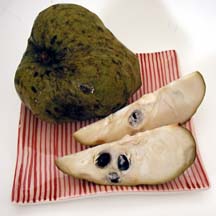
Eleanor Nakama-Mitsunaga
![]()
|
Although this exotic fruit has been in the islands since the 1800s, it's not uncommon to find locals who have never seen it, let alone tasted it. The cherimoya, its hybrid the atemoya and its cousins, sweetsop and soursop, are seasonal exotic fruit that often are mistaken for one another.
The basics: Cherimoya, also called custard apple, is native to South America, where the trees were originally grown by Inca farmers in Ecuador and Peru. It is considered a winter fruit in Hawaii, where the season begins sometime in November or December and runs through March or April.
The fruit has grown successfully using a hand-pollination technique on Maui and the Big Island and is commercially available in limited supply.
Cherimoya is a green, heart-shaped fruit with distinctive smooth, petal-like skin. It averages a half-pound to a pound in size with creamy white flesh and several inedible black seeds.
The texture of the fruit has been compared to a ripe peach with a sweet, juicy and slightly tart flavor. The taste is very tropical in nature, with essences of pineapple, mango, banana, papaya and passion fruit. Cherimoya is high in fiber, iron and niacin.
Selecting: Cherimoya is generally harvested green and needs to be ripened for a couple of days at room temperature. Look for fruit that is firm and bright green without blemishes. Watch out for cracks in the skin. As the fruit ripens it will yield to pressure and turn a darker green.
Storing: Store ripened fruit in the refrigerator for several days.
Use: Cut cherimoya into wedges, remove seeds and scrape out flesh. The flesh can also be added to smoothies, fruit salads or made into ice cream or sorbet.
Where to buy: Peak-season cherimoyas are available at Kapiolani Community College's Saturday Farmers' Market and throughout Chinatown. Prices range from $2 to $3 a pound.
Eleanor Nakama-Mitsunaga is
a free-lance food writer. Contact her
online through features@starbulletin.com


